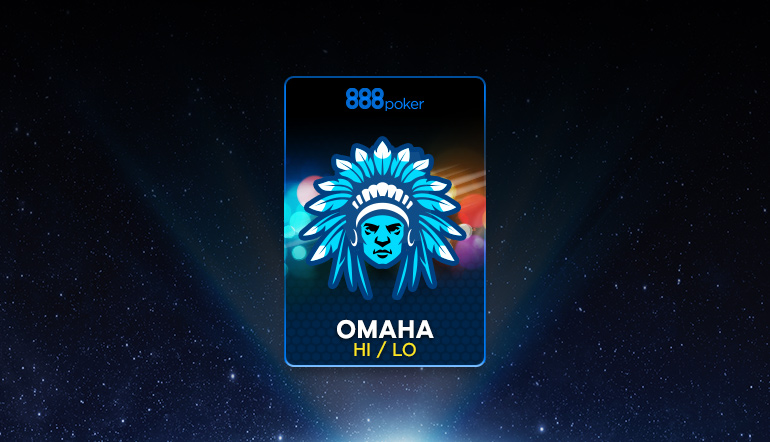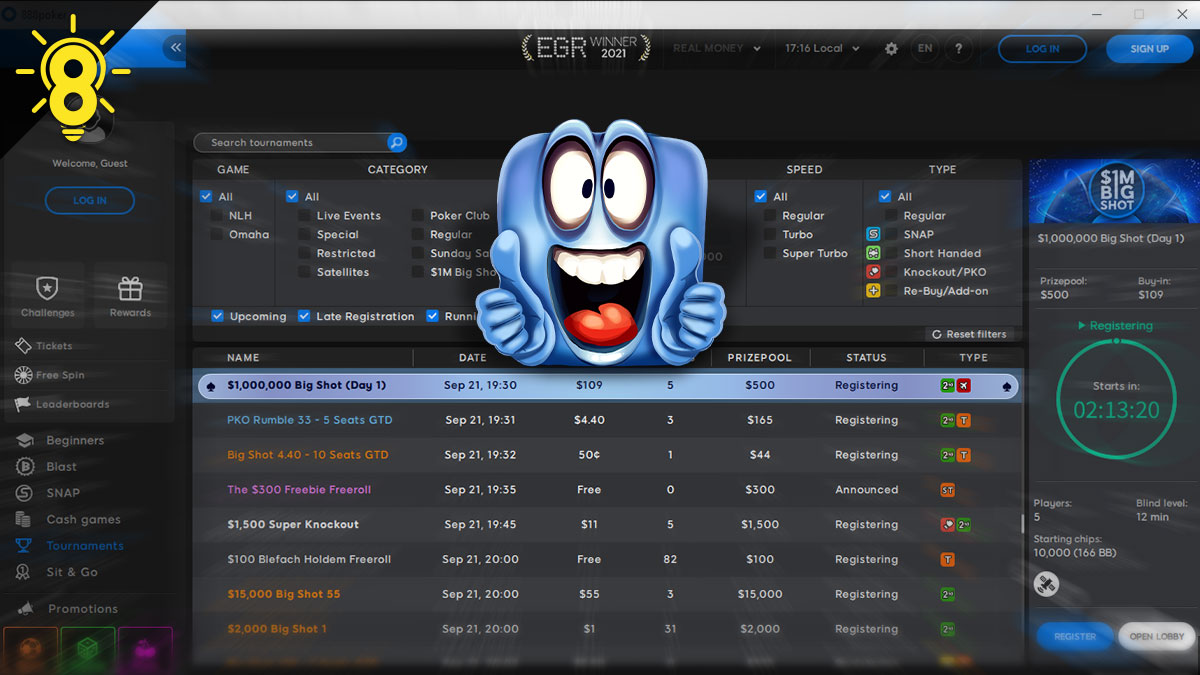If you've experienced the adrenaline rush of skydiving, then you can relate to the thrill of playing Pot Limit Omaha (PLO)! This engaging game offers substantial pots and powerful hands. Omaha Hi It’s not just about the excitement; the game also features more significant draws. The well-known words of Sammy Farha, \"Let’s gamble…\", capture the essence of this poker style perfectly. showdown However, before jumping into the action at 888poker, take some time to familiarize yourself with the game rules and some basic Omaha poker strategies. Having good hands is one thing, but successfully winning with them is a different challenge altogether.
Omaha Poker Strategy – Core Principles hands To begin with, in Omaha, every player is dealt 4 hole cards. If you think this increases the volatility of the game, you're absolutely correct. This setup typically means that the average winning hand in Omaha is much more formidable compared to other variants.
Let's get started!
Here's the rationale: each hand consists of 6 different two-card combinations due to the 4 hole cards, rather than just 1 combination like in Hold'em. If we assign letters to the cards, we have combinations like A-B, A-C, A-D, B-C, B-D, and C-D. Meanwhile, in Hold'em, with only 2 starting cards, the combination is simply A-B.
The multitude of hand combinations significantly emphasizes the necessity of drilling down into the essential strategies of the game. The complexity in how hands are formed can often be overwhelming. The Pot-Limit Omaha Poker Tips listed below are crafted to clarify matters and equip you with the key tools needed to relish the game while accumulating winnings. Holdem .
A common pitfall for many Pot Limit Omaha players is overestimating the value of their starting hands, particularly hands such as K-K-x-x. In Omaha-Hi, high pocket pairs are generally much weaker than in Hold'em. For instance, Kings come in at a distant second place on the Hold'em best starting hands chart.
Take a look at the rankings below for the top starting hands in PLO; you'll likely be surprised. Kings only find themselves in the eighth spot, and that's with accompanying Q-Q kickers.
1. Starting Hands
Realistically, Omaha is a game centered around making draws, and a singular pair of Aces isn't sufficient to secure a victory.
Check out this list of the Top Ten Best Starting Hands:
Many diehard PLO enthusiasts feel compelled to play Aces no matter the position or situation, often taking them to the river without hesitation. Yet, not all Aces hold the same value. Of course, Aces are significant in virtually all poker types, including Omaha. However, you should seek Aces that are paired with cards capable of forming straights or flushes. This approach allows you to draw towards a winning hand even if you miss a set.
Remember, your opponents will likely be drawing as well. So, if you find yourself in a multi-way pot with a board like 10s-9d-6h-4c and you only have Aces, it may be wise to consider folding.
- A A K K - Double-suited
- A A J 10 - Double-suited
- A A Q Q - Double-suited
- A A J J - Double-suited
- A A 10 10 - Double-suited
- A A 9 9 - Double-suited
- J 10 9 8 - Double-suited
- K K Q Q - Double-suited
- K Q J 10 - Double-suited
- K K J J - Double-suited
The key principle of drawing in PLO is that with more opponents involved, your focus should be on drawing to the best possible hand.
In Hold'em, you typically aim for two types of draws: flushes and straights. Omaha has these draws too, but the number of potential flushes and straights is significantly higher since each player holds 4 cards. Forget about the conventional 9-out flush draws and 8-out straight draws.
2. Drawing Hands
For instance, if you're holding 9s-8d-7s-6d and the flop reveals 5d-3d-6h, in Hold'em with an 8d-7d hand, you would have 8 outs for a straight along with another 7 outs for a flush, totaling 15 drawing outs.
In PLO, you'd possess 4, 7, 8, or 9 for a straight. Your outs include 4 of a kind, 3 of sevens, 3 of eights, and 3 of nines, giving you 13 straight outs. Plus, you have an additional 6 cards (not counted among the straight outs) for the flush, culminating in a total of 19 drawing outs!
This is where the situation becomes complicated. In multi-way pots, your flush draw might already be dead since someone likely has a stronger draw. If a 7 hits the turn followed by an 8 on the river, your straight could easily be outclassed by a better hand like 10-9. straight Nonetheless, despite the risks, if you manage to complete the straight, the hand remains quite powerful. Just keep an eye out for larger flush possibilities or cards that could outshine a completed straight.
As we've established, drawing hands are the backbone of PLO gameplay. In fact, they dominate the atmosphere of the game! Another kind of draw, known as “wraps,” is what Omaha-Hi players are always excited about.
Consider a scenario where you have a starting hand of 10-9-6-5, and the flop reveals 8-7-3 in a rainbow. This hand offers far more outs compared to the typical straight draw in Hold'em, indeed allowing for 20 possible cards that could enhance the player's hand!
You have 4 of a kind for 4 outs that would yield an 8-high straight.
3. Wraps
3 of a kind gives you a 9-high straight.
So what exactly are “wrap hands”?
3 of a kind contributes to a 10-high straight.
Take a look:
- 3 nines would result in a 10-high straight.
- 3 tens lead to a 10-high straight.
- 3 jacks yield a Jack-high straight.
- Essentially, a wrap indicates that a player possesses a straight that is 'wrapped' around at both ends. While many wrap hands have fewer outs compared to earlier examples, they can still be quite formidable, especially against hands with a single pair or even two pair.
- Below are some example wrap hands alongside the potential number of outs they provide.
- It’s important to note that when a flush draw is achievable, caution is necessary when drawing for straights. In multi-way pots with a flushy board, there is likely to be another player in the hand with a strong draw.
Additionally, pursuing the top end of a straight is generally advisable. Exercise caution when dealing with smaller wrap draws like 5-6-7-8, as a turned nut-straight could vanish if a 9 or 10 arrives on the river.
Have you ever had your Aces beaten in a No Limit Hold'em game? Brace yourself for a similar fate in PLO; pocket pairs, even the mighty Aces and Kings, can easily be dismantled. With 4 starting cards and the myriad of straight and flush draws available, there are countless avenues leading to the downfall of Big Pairs.
| Starting Hand | Flop | No. of Outs | Draw Type |
| 9-8-6-5 | K – 7 – 4 | 13 | 13 Card Wrap |
| 10-9-6-2 | A – 8 – 7 | 17 | 17 Card Wrap |
| 10-9-6-5 | A – 8 – 7 | 20 | 20 Card Wrap |
However, strategies do exist for securing wins with your powerful pocket pairs. First and foremost, you should aim to begin with high-quality cards. Ideally, your Aces should be double-suited (allowing for nut-flush draws), or at least be supplemented by other significant cards (like K-Q-J-10 for Broadway draws). These additional cards provide backup if you do not hit a set or a strong full house.
Nonetheless, Aces still hold tremendous value in PLO. With robust Aces, it’s typically wise to raise or 3-bet aggressively. This tactic aims to maximize your hand's value while also pushing out weaker hands from the pot. If you hit a strong draw, don’t hesitate to increase the bet; hopefully, your opponent is holding a lower flush draw, though you’ll be aiming for the nuts!
4. Playing Big Pairs
When in a position with subpar Aces, you might consider limping or calling a modest raise. If you happen to flop a set, your opponents may be caught unprepared. During aggressive pre-flop situations, folding a hand like Ad-Ac-7s-2h might be prudent. With two surviving Aces in the deck, your hand is likely in trouble unless you manage to hit one.
Any flop that is draw-heavy, where your Big Pair does not connect in any way, should be approached with caution. If you were the aggressor, don’t feel obligated to continue betting aggressively just to bolster a pot filled with draws. This approach differs markedly from standard practices in other formats.
- Pre-flop Play
In multi-way pots, if the board reads 8-7-3, it’s probable that at least one player is holding a hand like 10-9 or 6-5.
Nevertheless, remain vigilant. Players in PLO can be quite crafty! If you suspect an opponent may have an over-pair akin to your own on a board like the one mentioned above, don’t hesitate to engage. A check-raise might induce a fold faster than you can blink!
- Post-flop Strategy
Ultimately, PLO revolves around drawing hands. If your premium pocket pairs fail to secure a draw on the flop, it’s advisable to fold, check-fold, or simply exit the game. Hold'em strategy In PLO, using your position effectively is crucial for both building a pot and controlling a pot. By mastering these two elements, you'll expand your bankroll while managing the inevitable fluctuations of the game.
When you flop a powerful 20-out wrap draw, your goal should be to push as many chips into the pot as you can. You’ll likely outperform almost every hand at that moment, and increasing the pot size is in your best interest.
If you're out of position facing an overly aggressive bettor, try a check-raise. Conversely, when you are in a favorable position with a strong draw and encounter a bet, initiating a substantial pot-raise is an excellent strategy.
5. Using Your Position in PLO
Controlling pot size is notably simpler when you are acting from a favorable position. On boards that are rich in potential draws, opponents in early positions will usually attempt to check-raise you. Don't fall for this tactic; seize the opportunity to take the turn card at no cost and assess if either your hand improves or your opponents miss the mark. Once you secure a set, you’ll be in a commanding position, leaving their draws trailing behind.
- Building a Pot
Playing from out-of-position can be trickier. On a dry board, there’s little requirement to start betting the pot aggressively. Nonetheless, it’s vital to convey that you have the upper hand. Some players will call with middling pairs or incomplete draws, hoping to stumble upon a winning hand.
Stay alert for these passive players who tend to chase runner-runner scenarios. They can deplete your stack with a seemingly innocuous two pair on the river. While they may not fold to your bets, they are unlikely to raise either. If they fail to generate a second pair, you’ll scoop up the pot. If they do manage two pair, they won’t exert any pressure, ensuring you won't lose more chips.
- Controlling a Pot
Experience the excitement of 888poker Free Tournaments - they're on the house!
Check out our comprehensive list detailing deposit limits.
Here's a rapid method for transferring funds to fellow players.









